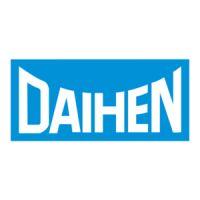3.8 Welding conditions of WB-M350L/M400L
3-24
3.8.2 Points for setting the conditions
The points to be observed when setting the welding conditions are set forth below.
Concerning the welding current and wire feed speed
The welding current (or wire feed speed) which is input as a welding condition becomes the
average current (or average wire feed speed) during welding. The welding waveform control
parameter optimally suited for the welding current (or wire feed speed) which has been set is
calculated automatically on the basis of the welding current (or wire feed speed) which has been
input.
Concerning the arc length tuning
The WB-M350L has two modes: synergic adjustments and individual adjustments.
When it is used in the synergic adjustment, the optimum voltage for the current which has been
set is output automatically. The “arc length tun.” is an adjustment value for increasing or reducing
the voltage which is output automatically. For instance, if a setting of +5 is used, the output
voltage will be raised by about 0.5 V as a theoretical value.
Concerning the input of the wire feed speed
The wire feed speeds which are actually valid as welding conditions differ according to the welder
and welding mode used. If the standard software has been installed in the welder, the minimum
speed is approximately 130 cm/min. and the maximum speed is approximately 1800 cm/min. as a
general rule. However, depending on the welding mode, the maximum and minimum wire feed
speed may be more restricted than the ranges given.
Concerning the setting range of the welding speed
Although any speed from 1 to 999 cm/min. can be set as the welding speed, the maximum speed
is actually 600 cm/min. or so. Since this is also the maximum operable speed and not a speed
which can be used for actual welding, it must be adjusted to ensure optimum welding.
Concerning the Arc char.1 (Short)
The arc characteristic is expressed in the form of a numerical value which enables the arc
hardness or softness to be set.
A “+” figure yields a soft arc with minimized short-circuit current peaks.
A “–” figure yields a hard arc yielded by a high short-circuit current.
Concerning the Arc char.2 (Arc)
As with the Arc char.1 setting, the values for this condition enable hard or soft to be set for
the arcs.
A “+” figure yields a soft arc with minimized current change in the arc discharge.
A “–” figure yields a hard arc with the large current change in the arc discharge.
In the case where the arc characteristic is set in “+” side, the further minimizing spatter may
be found in the current area where the angular-advance spatter-reducing effect can be
produced. However, if the value is set too high, the welding easily becomes unstable and the
electrical tolerance of the condition will drop to a lower value. A “–” figure setting yields a
stronger immunity to the fluctuations in the protruding wire and an improved stability of the
posture welding. Note that if the high value is set in the respective sides “+” and “–”, the
welding may become unstable.
Normally, set the same values to Arc char.1 (Short) and Arc char.2 (Arc).
What is the slowdown speed?
The slowdown speed denotes the speed at which the wire is fed until the arc is started at the arc
start point.
When crater treatment is not performed
When crater treatment is not going to be performed, set the crater time to “0.” However, in this
case, set the same conditions as for regular welding as the crater current or wire feed speed
setting value. Unless the same conditions are set, the appropriate burnback voltage level may not
be displayed properly at the teaching stage.
When the crater time has been set at 0, the “Welding method” for the arc end
condition shall be set to the same one for the main welding.

